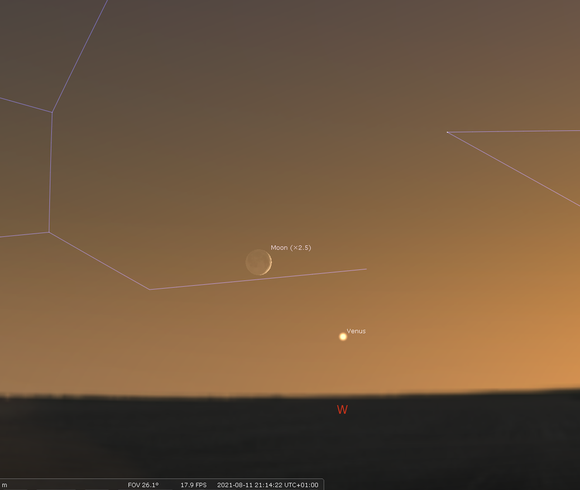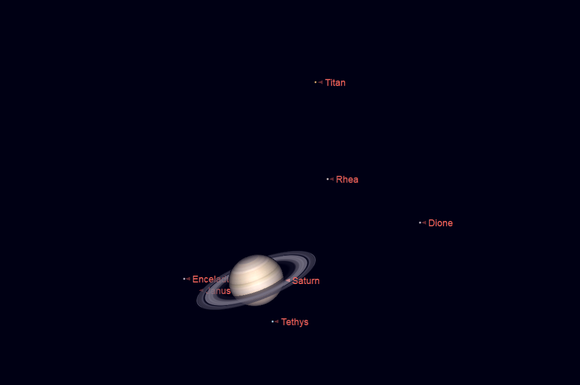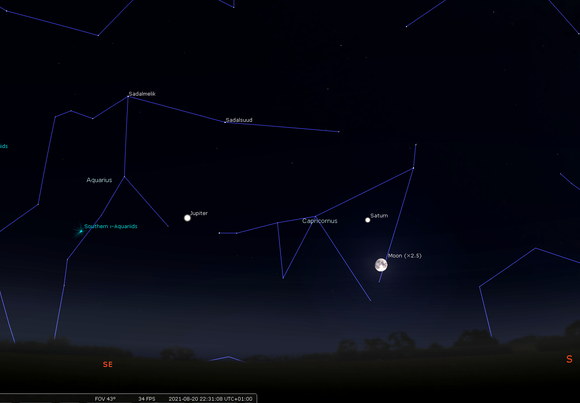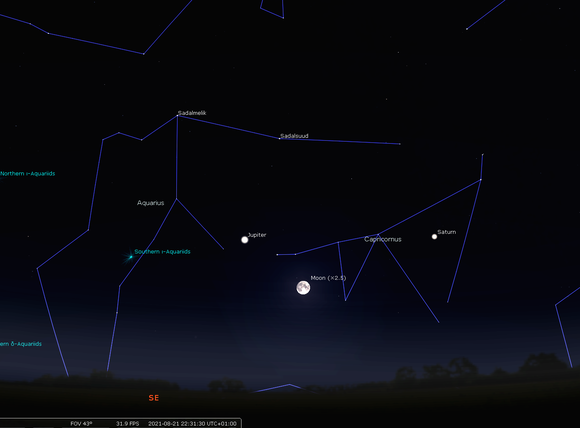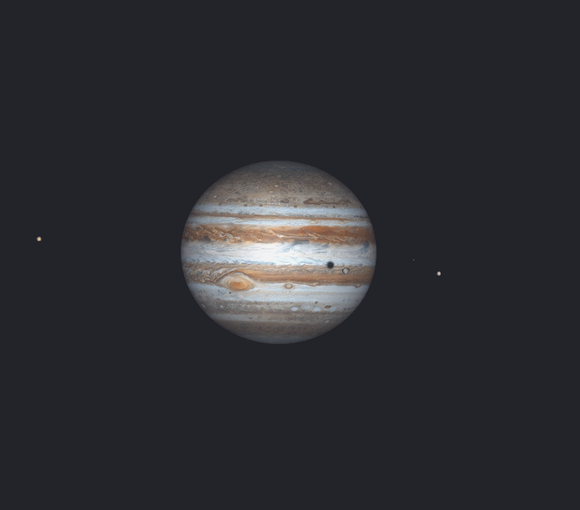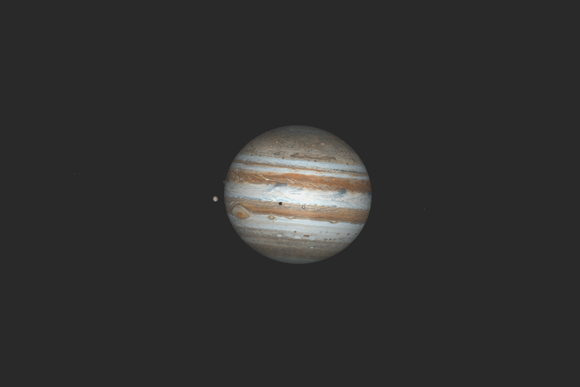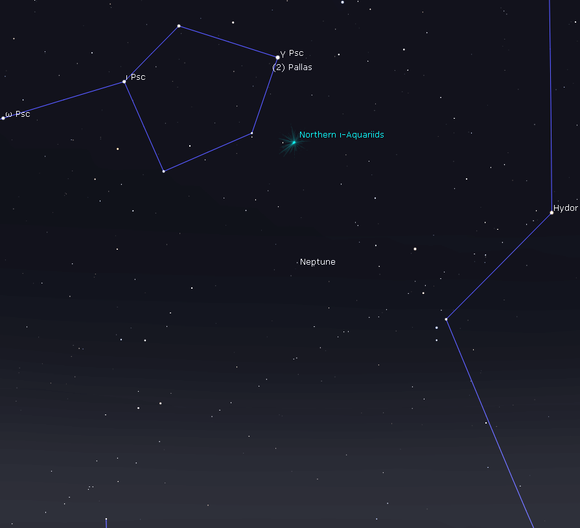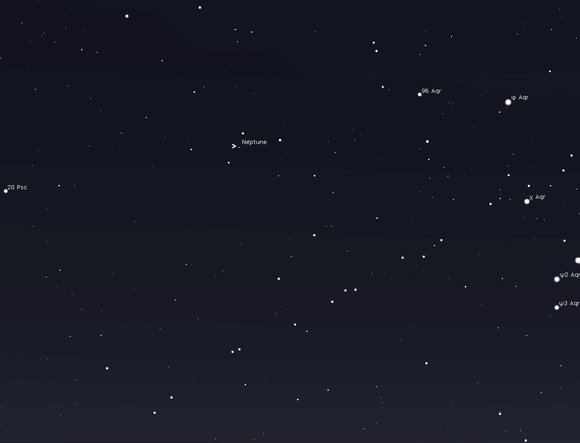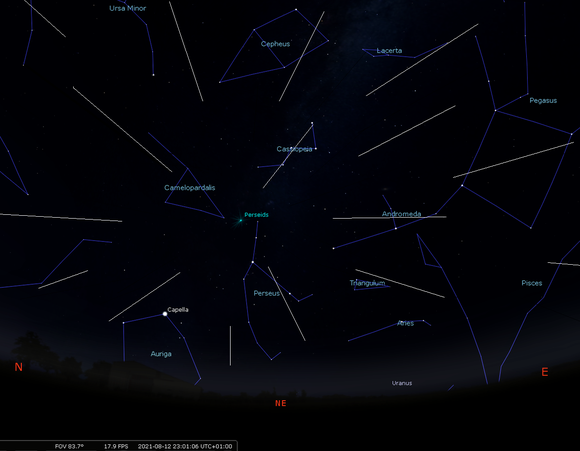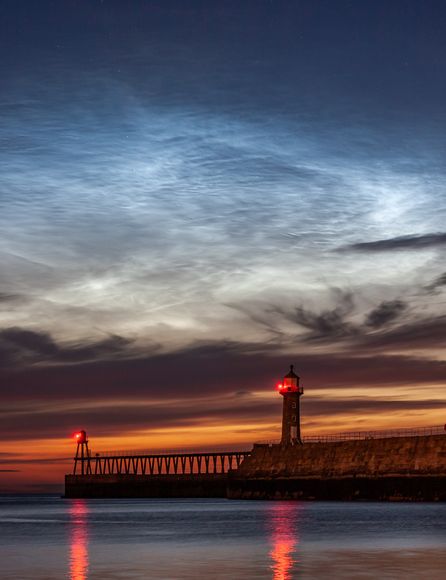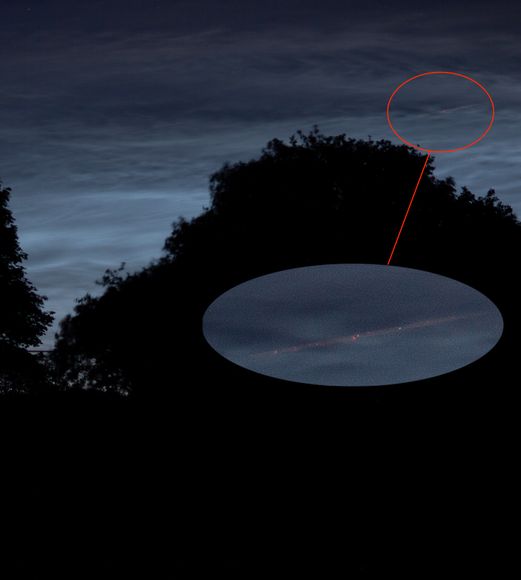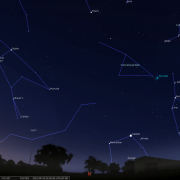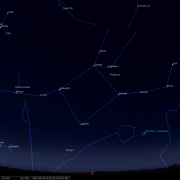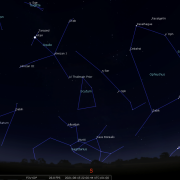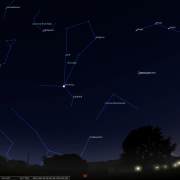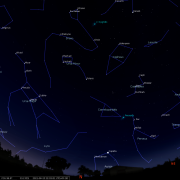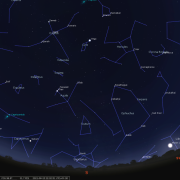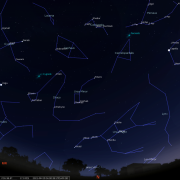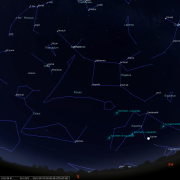In this month's Sky Notes:
- Planetary Skylights.
- August Meteors - the Perseids.
- Noctilucent cloud display.
- August 2021 Sky Charts.
Planetary Skylights - Brief
Both Jupiter and Saturn come to opposition this month, Saturn on the 2nd and Jupiter on the 20th. Venus more or less holds station, reluctant to venture away from the vicinity of the west horizon. Mars is now lost in solar glare, whilst Mercury struggles to leave it, and is unlikely to be spotted from our shores. Neptune can be tracked down in the late evening sky, and comes to opposition next month, whilst Uranus is an early morning object.
 Venus remains stubbornly low in the W twilight sky, just 6 or 7 degrees above the horizon. At magnitude -3.7 it should be easily spotted, but from recent experience tracking it down in July, this brilliance is often diminished by haze and the lighter sky conditions present, resulting in Venus being trickier to spot than would normally be expected. An unobstructed W aspect is required otherwise you won't spot Venus at all. Look for a slither of a new moon upper left of Venus on the 11th, view at 21:15hrs BST. Locate Venus first and then scan with binoculars to spot the wafer crescent. In the eyepiece of a telescope Venus will appear somewhat unstable, but you may be able to discern the phase, equivalent to a lunar Quarter phase... just more wobbly! By the end of the month Venus will be edging back toward the horizon, almost as if it had second thoughts about really making an impact in the western twilight sky.
Venus remains stubbornly low in the W twilight sky, just 6 or 7 degrees above the horizon. At magnitude -3.7 it should be easily spotted, but from recent experience tracking it down in July, this brilliance is often diminished by haze and the lighter sky conditions present, resulting in Venus being trickier to spot than would normally be expected. An unobstructed W aspect is required otherwise you won't spot Venus at all. Look for a slither of a new moon upper left of Venus on the 11th, view at 21:15hrs BST. Locate Venus first and then scan with binoculars to spot the wafer crescent. In the eyepiece of a telescope Venus will appear somewhat unstable, but you may be able to discern the phase, equivalent to a lunar Quarter phase... just more wobbly! By the end of the month Venus will be edging back toward the horizon, almost as if it had second thoughts about really making an impact in the western twilight sky.
 Saturn comes to opposition on the 2nd and hence will be visible throughout the night, residing due south around the midnight hour. Situated amongst the stars of Capricornus, Saturn has been languishing on the ecliptic south of the celestial equator amongst the southerly constellations on the zodiac for quite a few years now. Consequently it has not been at its best to observe, but this is gradually changing as it edges higher into the sky over the coming years. At an apparent magnitude of +0.1, its pearly white lustre will be conspicuous in comparison to the faint stars of Capricornus, but seem rather feeble when compared the brilliance of Jupiter, located off to its left. Although rising approximately half an hour ahead of Jupiter, Saturn will seem to emerge in the dusk sky after Jupiter appears, around 21:35hrs on opposition night at the start of August. Saturn will then be best placed for observations between 23:30hrs-01:30hrs, just shy of 20 degrees above the southern horizon and a viable observing target.
Saturn comes to opposition on the 2nd and hence will be visible throughout the night, residing due south around the midnight hour. Situated amongst the stars of Capricornus, Saturn has been languishing on the ecliptic south of the celestial equator amongst the southerly constellations on the zodiac for quite a few years now. Consequently it has not been at its best to observe, but this is gradually changing as it edges higher into the sky over the coming years. At an apparent magnitude of +0.1, its pearly white lustre will be conspicuous in comparison to the faint stars of Capricornus, but seem rather feeble when compared the brilliance of Jupiter, located off to its left. Although rising approximately half an hour ahead of Jupiter, Saturn will seem to emerge in the dusk sky after Jupiter appears, around 21:35hrs on opposition night at the start of August. Saturn will then be best placed for observations between 23:30hrs-01:30hrs, just shy of 20 degrees above the southern horizon and a viable observing target.
The glorious rings are still well orientated with respect to Earth, but are now slowing closing up again, with the North Pole tilted toward Earth by nearly 17 degrees. In the eyepiece Saturn remains a glorious sight, although the disk size of 18.5 arc seconds is less than half that of Jupiter's, but then again Saturn is twice as far away. When you factor in the rings however, the overall image compares more than favourably with Jupiter. A scope with an aperture of 80-100mm (3.5-4") will reveal the two brightest rings; ring A (the outermost) and ring B. These are separated by the Cassini Division, but to fully observe this requires scopes of 150mm (6"). Ring C lies closest to the disk but is difficult to spot, especially when Saturn is rather low. Saturn has at least 60 moons, most of which are very small, but you should at least spot Titan, its largest moon as a speck nearby. Titan is bright enough (mag+8.4) to be spied in binoculars even. Titan takes just under 16 days to orbit round Saturn. Scopes of 200mm + (8") will also reveal Rhea, Tethys and Dione as well as Iapetus. Although Saturn comes to opposition on the 2nd, for UK observers it will be better placed in the late evening from the end of August.
 Jupiter trails Saturn by around 35 minutes, and hence comes to opposition later in the month, around Aug 19/20th. It is much brighter almost reaching mag -2.9, although the low altitude will diminish this to around -2.3. The good news for UK observers is that compared to last year, Jupiter will culminate almost 9 degrees higher in the sky, residing as it does on the Aquarius/Capricornus border. The extra altitude equates to 'better seeing' and a longer observing window. At the start of August Jupiter will be apparent from most UK locations by 22:00hrs BST and an hour earlier by opposition date. Jupiter will be at its highest above south horizon (culmination) shortly after 01:00hrs- equating to around 23 degrees from mid UK latitudes; a little higher further south, lower further north. It will actually reside above the 20 degree barrier for almost 4 hours, from 22:00hrs to 02:00hrs BST. By the end of the month Jupiter will visible by 20:00hrs.
Jupiter trails Saturn by around 35 minutes, and hence comes to opposition later in the month, around Aug 19/20th. It is much brighter almost reaching mag -2.9, although the low altitude will diminish this to around -2.3. The good news for UK observers is that compared to last year, Jupiter will culminate almost 9 degrees higher in the sky, residing as it does on the Aquarius/Capricornus border. The extra altitude equates to 'better seeing' and a longer observing window. At the start of August Jupiter will be apparent from most UK locations by 22:00hrs BST and an hour earlier by opposition date. Jupiter will be at its highest above south horizon (culmination) shortly after 01:00hrs- equating to around 23 degrees from mid UK latitudes; a little higher further south, lower further north. It will actually reside above the 20 degree barrier for almost 4 hours, from 22:00hrs to 02:00hrs BST. By the end of the month Jupiter will visible by 20:00hrs.
Through the eyepiece Jupiter is a terrific sight, and many amateur astronomers consider it the most interesting planet to observe. During August the noticeably oblate disk will be a whopping 49 arc seconds in diameter, so there will be a good deal to observe. Even small telescopes will reveal the dark belts and bright zones, as well as the Galilean moons, adjacent to the disk. Scopes of 6" (150mm) or larger will reveal finer detail in the Jovian atmosphere including the Great Red Spot (GRS) feature, a vast storm which has been diminishing in size and colour intensity over recent years, but may now be re-establishing itself. It's certainly worth keeping tabs on from year to year, even month to month! The GRS can be seen on Jupiter before midnight on the following dates; Aug 3/4, 8/9, 10/11, 15/16, 20/21, 22/23 and 27/28th.
Observers of the Jovian system will of course follow the 'dance' of the Galilean moons around Jupiter, throwing up a different configuration each night. The four major moons are visible in 10x50 binoculars as specks of light. Very small telescopes won't actually reveal much more, but 4" (100mm) aperture scopes and above, will show the cast shadow of a moon passing on the near side of Jupiter upon its disk. These 'shadow transits' are fascinating to follow, jet black dots of varying size. The actual moons themselves are more difficult to spot as they pass in front of Jupiter, requiring much larger apertures. The most favourable shadow transits this month are on the 22nd and 29th (see below). Should you be observing on the 1/2nd two of the Galilean moons are involved in an eclipse.
Jupiter's Great Red Spot and shadow transit and transit of Ganymede Aug 22 23:00hrs
(Click for larger image)
 Neptune is visible in the late evening sky low to the east by late August and comes to opposition next month. It is located midway between the faint loop of stars in Pisces marking one fish and Aquarius. At magnitude +7.7 Neptune is visible in binoculars, but in reality a telescope of 100mm apperture is required to make out the ting blue/grey disk. A more detailed chart will be posted next month, when Neptune will be better placed at a more convenient hour. The other outer gas 'twin' - Uranus, rises in the early morning hours. A chart will be given in next month's notes.
Neptune is visible in the late evening sky low to the east by late August and comes to opposition next month. It is located midway between the faint loop of stars in Pisces marking one fish and Aquarius. At magnitude +7.7 Neptune is visible in binoculars, but in reality a telescope of 100mm apperture is required to make out the ting blue/grey disk. A more detailed chart will be posted next month, when Neptune will be better placed at a more convenient hour. The other outer gas 'twin' - Uranus, rises in the early morning hours. A chart will be given in next month's notes.
Meteors - August Activity - The Perseids

August is certainly one of the better months for observing shooting stars, with one of the more reliable and prolific meteor showers reaching a peak; the Perseids. Given the time of year, it is probably the most widely observed shower by the general public, especially when conditions are favourable, as they will be this year with the Moon having set by 22:00hrs BST. Whether natures great free firework display will be hampered by adverse weather, that cannot be predicted at this stage.
Sometimes known as "The tears of St. Lawrence"; the martyred Christian deacon whose feast day falls on Aug 10th, just two days before the Perseids peak, these particular ‘tears’, like the majority of meteor showers are composed of debris deposited over thousands of years by periodic comets, the Perseids being associated with comet Swift Tuttle, which has an orbital period of around 133 years. It appeared last in 1992 when enhanced rates were seen. Perseid meteoroids are not dissimilar in size and density to that of instant coffee granules with the occasional pea or marble sized fragment. Each August, Earth encounters various strands of the Swift-Tuttle debris stream giving rise to the eagerly anticipated shooting stars.
Penetrating the upper atmosphere some 60 miles up, Perseid 'meteoroids' reach speeds of 43miles/second, interacting with atoms as they push through the air, a process known as ablation, before becoming ionised and releasing a packet of light. It is this brief luminous flash we call a meteor. Particularly bright examples often leave behind persistent ionisation trails in their wake, the classic shooting star. The radiant of the shower: the location in the sky from which the meteors appear to emanate, lies within the constellation of Perseus, which in August is rising in the north east during the evening. The first signs of Perseid activity start in late July, but rates are highest from Aug 8th-15th normally reaching a peak near the night of the 12th. Under ideal conditions the zenith hourly rate (ZHR) for the Perseids is typically quoted around 80-100, however actual observed rates are somewhat lower, but an observer can still expect to catch 30-40 per hour, normally in the early morning hours.
This year the peak is expected to occur between 20:00hrs and 22:00hrs BST on the evening of the 12th. Observers would expect to see perhaps a dozen meteors as dusk falls, given that the radiant will still be low. By midnight numbers will have increased, but the highest rates will be witnessed from 01:00 to 02:00hrs; the early morning hours of the 13th. Do not just observe on this date only - the night of 11/12th may also be productive. Try to observe in areas of the sky a good hand span away from Perseus and between 40-70 degrees above the horizon. Good hunting.
A fine display of noctilucent cloud. Image by Richard Randle;
early morning hours of June 15th (click for larger)
There have been one or two Noctilucent Cloud displays early summer, a perticularly nice display occuring on June 15th, which was witnessed and imaged by society member Richard Randle; a great image it is too! Richard imaged a further display on July 14th and drew my attention to one image in particular. This was taken at 23:42hrs and shows some kind of trail or streak or perhaps something breaking up. I believe the length of exposure was 5 seconds, which may indicate that the anomally may be caused by a plane with navigation lights blinking. It perhaps may be a satelite or trail of satelites, or may be something breaking up, though i don't think its a meteor. Anyone have any suggestions? The Noctilucent cloud season normally comes to an end by early August, but it will still be worth keeping an eye out low to the north a few hours after sunset for a little while yet... you never know.
Additional Image Credits:
- Planets and Comets where not otherwise mentioned: NASA
- Sky Charts: Stellarium Software and Starry Night Pro Plus 8
- Log in to post comments

